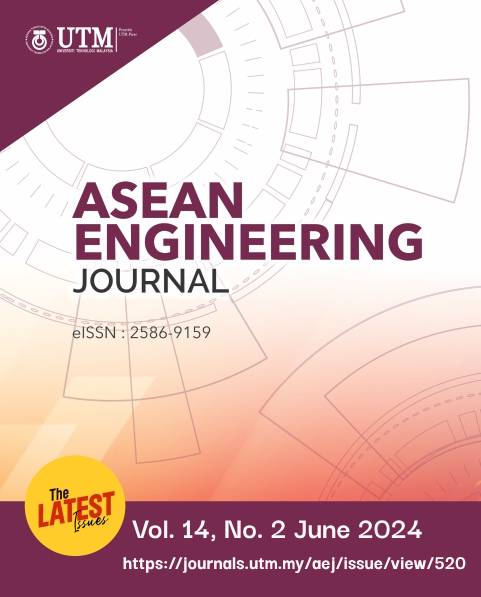ENERGY EFFECTIVE HETEROGENEOUS GROUPING IDEAL TRANSMISSION SYSTEM WITH FUZZY IDENTIFICATION IN UWSNTION IN UWSN
DOI:
https://doi.org/10.11113/aej.v14.20850Keywords:
Energy Consumption, Fuzzy Identification, Heterogeneous Clustering, Packet Delivery, Routing Performance, QoS, Underground Wireless Sensor Networks.Abstract
Network connectivity is the fundamental issue for ensuring the longevity of the networks in underground wireless sensor networks. Other important factors are consider in the WSN is minimum path count, energy usage, and packet delivery ratio. There are numerous approaches that might be used to extend the life of UWSN, however sustaining the energy level of network in underground locations in soil is still a challenge. It is projected that the Energy Effective Heterogeneous Grouping Ideal Transmission System with Fuzzy Identification (EEHG-ITSFI) technique will significantly lower the amount of energy used to transport data from node to bottom station and will increase the network of subterranean devices' useful life. Using EEHC-OTSFI, which randomly chooses a cluster head from the collection of clusters, the sensors are grouped into clusters. A fuzzy identification technique is used to focus this connectivity, which is seen as a QoS indication. The network's packet delivery is sped up and delayed less thanks to fuzzy identification technology. The ability to combine different variables into a single indicator, which demonstrates creative presentation for the growth of routing performance in WSNs, is the key benefit.The suggested methodology maximises lifetime in heterogeneous Underground Wireless Sensor Networks (UWSN) while lowering energy consumption by 25–30%, average hop count by 38–42%, and packet latency by up to 40–44%.
References
P.Rama, S.Murugan.,2019.Energy Harvesting for Lifetime Maximization of the Underground Sensor Networks via FFC in Underground Mining. International Journal of Innovative Technology and Exploring Engineering (IJITEE). 8(7S): 11-18. https://www.ijitee.org/wp content/uploads/papers/v8i7s/G10030587S19.pdf
Arandia Jimenez, M., 2020. Locating Relay Nodes to Maximize Wireless Sensor Network Lifetime: A Numerical Study. Industrial Engineering Undergraduate Honors Theses Retrieved from. https://scholarworks.uark.edu/ineguht/68.
Peng, Song, and Yonghua Xiong., 2020. A Lifetime-Enhancing Method for Directional Sensor Networks with a New Hybrid Energy-Consumption Pattern in Q-coverage Scenarios. 13(4). https://www.mdpi.com/1996-1073/13/4/824/htm.
Rodríguez, Alma & Del Valle Soto, Carolina & Velázquez, Ramiro., 2020. Energy-Efficient Clustering Routing Protocol for Wireless Sensor Networks Based on Yellow Saddle Goatfish Algorithm. Mathematics. 8(15). https://DOI:10.3390/math8091515.
Pal, R., Yadav, S., Karnwal, R. et al., 2020. EEWC: energy-efficient weighted clustering method based on genetic algorithm for HWSNs. Complex Intell. Syst. 6: 391–400. doi: https://doi.org/10.1007/s40747-020-00137-4.
Rajeev Ranjan, Sinduja KM, Vinay G., 2019. A Survey on Fuzzy Based Sensor Network and Its Applications. Int. Jnl. of Advanced Networking & Applications (IJANA). 10(5). https://www.ijana.in/papers/16-NCACTA_215.pdf.
Sai Krishna Mothku, Rashmi Ranjan Rout., 2019. Adaptive Fuzzy-Based Energy and Delay-Aware Routing Protocol for a Heterogeneous Sensor Network. Journal of Computer Networks and Communications. 11. doi: https://doi.org/10.1155/2019/3237623.
Chowdhury, Sultan & Hossain, Ashraf., 2020. Different Energy Saving Schemes in Wireless Sensor Networks: A Survey. Wireless Personal Communications. doi: https://doi.org/10.1007/s11277-020-07461-5.
Anisi, M.H., Abdul-Salaam, G., Idris, M.Y.I. et al., 2017. Energy harvesting and battery power based routing in wireless sensor networks. Wireless Network, 23: 249 266. Doi: https://doi.org/10.1007/s11276-015-1150-6.
Alsharif, M.H.; Kim, S.; Kuruoğlu, N., 2019. Energy Harvesting Techniques for Wireless Sensor Networks/Radio-Frequency Identification: A Review Symmetry. 11: 865. doi: https://doi.org/10.3390/sym11070865.
Hamzah A, Shurman M, Al-Jarrah O, Taqieddin E., 2019.Energy-Efficient Fuzzy-Logic-Based Clustering Technique for Hierarchical Routing Protocols in Wireless Sensor Networks. Sensors (Basel). 19(3):561. doi: https://doi:10.3390/s19030561.
Bhushan, S., Kumar, M., Kumar, P. et al., 2021. FAJIT: a fuzzy-based data aggregation technique for energy efficiency in wireless sensor network. Complex Intell. Syst. 7:997–1007. doi: https://doi.org/10.1007/s40747-020-00258-w.
R. Du, L. Gkatzikis, C. Fischione and M. Xiao. Sept., 2018. On Maximizing Sensor Network Lifetime by Energy Balancing.in IEEE Transactions on Control of Network Systems. 5(3): 206-1218. doi: https://doi: 10.1109/TCNS.2017.2696363.
A. Attiah, M. Chatterjee and C. C. Zou., 2017. A Game Theoretic Approach for Energy-Efficient Clustering in Wireless Sensor Networks. IEEE Wireless Communications and Networking Conference (WCNC). 1-6. doi: https://doi: 10.1109/WCNC.2017.7925668.
Hasan, M., Al-Rizzo, H. & Günay. M., 2017. Lifetime maximization by partitioning approach in wireless sensor networks. J Wireless Com Network,15. doi: https://doi.org/10.1186/s13638-016-0803-1.
F. X. Li, A. A. Islam, A. S. Jaroo, H. Hamid, J. Jalali and M. Sammartino., 2015. Urban highway bridge structure health assessments using wireless sensor network. 2015 IEEE Topical Conference on Wireless Sensors and Sensor Networks (WiSNet), 75-77. https://ieeexplore.ieee.org/document/7127417.
S. Shandilya, M. K. Meena and N. Kumar., 2015. A low cost wireless sensor development for assessing ground reaction force in gait analysis. 2015 Annual IEEE India Conference (INDICON),1-3, doi: https://doi: 10.1109/INDICON.2015.7443725.
S. Astapov, A. Riid and J. Preden., 2016. Military vehicle acoustic pattern identification by distributed Ground Sensors. 15th Biennial Baltic Electronics Conference (BEC), 167-170. doi: https://doi.org/ 10.1109/BEC.2016.7743755.
R. Kirichek, I. Grishin, D. Okuneva and M. Falin., 2016. Development of a node-positioning algorithm for wireless sensor networks in 3D space. 18th International Conference on Advanced Communication Technology (ICACT).279 282.https://doi.org/10.1109/ICACT.2016.7423359.
W. Elgenaidi, T. Newe, E. O'Connell, A. Mathur, D. Toal and G. Dooly. , 2017. Reconfiguration of neighbouring nodes in coastal monitoring wireless sensor networks based on leader node recommendation 2017 4th International Conference on Control, Decision and Information Technologies (CoDIT), 348-0352. https://doi.org/ 10.1109/CoDIT.2017.8102616.
Materum, L., & Teologo Jr., A. T., 2021. An Improved K-Power Means Technique Using Minkowski Distance Metric and Dimension Weights for Clustering Wireless Multipaths in Indoor Channel Scenarios. Journal of Information and Communication Technology, 20(4): 541–563. https://doi.org/10.32890/jict2021.20.4.4.
Sun, H., Han, F., Zhao, S. et al., 2022. Optimal energy-harvesting design for AF and DF two-way relay beamforming in 6G. J Wireless Com Network 2, 73. doi: https://doi.org/10.1186/s13638-022-02155-x.
Sharma, Richa, Vasudha Vashisht and Umang Singh. 2020. “Metaheuristics-based energy efficient clustering in WSNs: challenges and research contributions”, IET Wirel. Sens. Syst. 10: 253-264. Doi: doi: 10.1049/iet-wss.2020.0102.
John, Jean & Muthukrishnan, Anuradha & Soundaram, Jothi., 2022. Energy‐efficient model using optimal route discovery based on adaptive spider monkey optimization model. International Journal of Communication Systems. 35. doi: https://doi.org/10.1002/dac.5256.
John Nicot, Nicot J, Fadel L, Taris T. 2021. An Autonomous Wireless Sensor Node Based on Hybrid RF Solar Energy Harvesting. Wireless Power Transfer 8: 6642938. doi: https://doi.org/10.1155/2021/6642938.
















